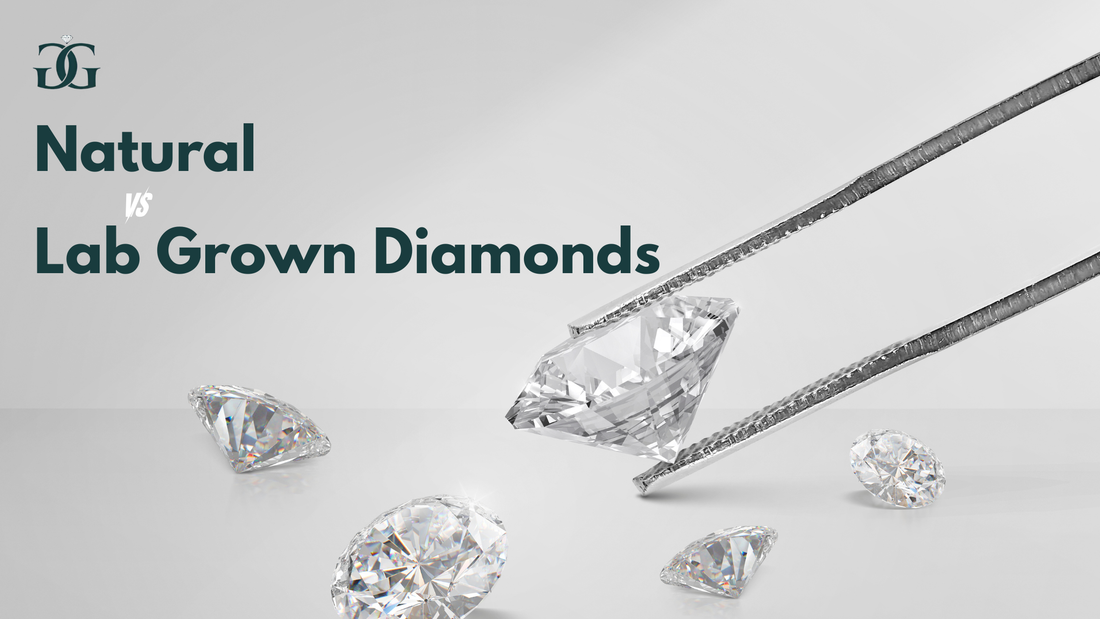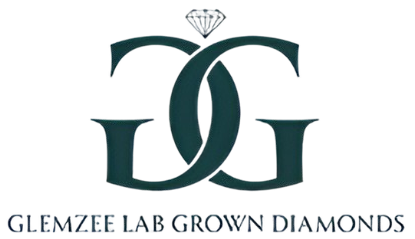
Lab-Grown Diamonds vs Natural Diamonds – What’s the Real Difference?
Share
When you’re considering a diamond jewellery piece — whether an engagement ring, a milestone gift or a treat-yourself splurge — you’ll soon face the question: should I buy a natural (mined) diamond or a lab-grown diamond? At first glance, both sparkle, both look beautiful — so what really sets them apart? In this in-depth guide we’ll explore the science, the cost, the ethics, the value retention and the buying tips, so you can confidently choose what aligns with your values, budget and style.
What Are Lab-Grown Diamonds?
“Lab-grown” doesn’t mean fake. In fact, lab-grown diamonds are real diamonds — the same chemical composition (carbon atoms in diamond crystal lattice), the same hardness (10 on the Mohs scale) and the same optical brilliance as natural diamonds.
They are created in a controlled environment (a laboratory), using methods such as High Pressure High Temperature (HPHT) or Chemical Vapour Deposition (CVD). Because the manufacturing time is weeks instead of millions or billions of years (as with natural diamonds) the origin is different — but the finished gem is functionally identical.
How Are They Made – The Science Behind Lab Diamonds
Natural diamonds form deep beneath the Earth’s surface, under immense heat and pressure over millions to billions of years, then are brought to the surface by volcanic activity.
Lab-grown diamonds, by contrast, replicate those conditions in weeks. For example:
-
HPHT: a diamond “seed” is placed under extremely high pressure and high temperature, carbon is added, and diamond crystals grow.
-
CVD: a diamond seed is placed in a chamber, carbon atoms are deposited layer by layer via plasma, building up the diamond crystal.
Because the process is accelerated and controlled, manufacturers can produce large, high-quality stones more reliably. But also, the supply is less limited — which has ramifications for price, exclusivity and resale value.
Price, Purity & Sustainability Comparison
Price
One of the biggest driving factors: lab-grown diamonds often cost significantly less than natural diamonds of the same “4 Cs” (cut, colour, clarity, carat). According to one source, lab-grown can cost 60-85% less.
Another source cites up to 70-90% cheaper
This means you can often afford a larger or higher grade lab-grown diamond for the same budget as a smaller natural diamond.
Purity & Quality
Because the growth environment is controlled, lab-grown diamonds can have fewer inclusions (though they can also have different inclusion types) and the 4 Cs grading applies similarly.
It’s important to note that the visual difference to the naked eye between a lab-grown diamond and a natural diamond of equal grade is effectively nil.
Therefore, in terms of day-to-day wear, durability, sparkle, you’re not giving up much if you choose lab-grown — provided you buy from a trusted jeweller with certification.
Sustainability & Ethics
For many buyers, this is the key differentiator. Natural diamonds require mining — often large-scale, with environmental disturbance, workforce issues, transport, etc. Lab-grown diamonds avoid some of this mining burden.
However, it’s not black-and-white: lab production uses energy (especially in HPHT) and one must ask whether the energy source is renewable, whGlemzeeether the manufacturer is transparent, etc.
If your brand positions itself as sustainable luxury, highlighting the ethical and environmental advantages (reduced mining, lower transport, traceability) can be a strong asset.
Why Modern Buyers Are Switching to Lab Diamonds
There are several reasons why lab-grown diamonds are gaining popularity — especially among younger, value- and ethics-driven buyers:
-
Better value for money: For the same budget you can get more size, better quality, or both.
-
Ethical peace of mind: Knowing the diamond was grown in a clean, controlled environment, no concerns about conflict mining, fewer unknown supply-chain risks.
-
Sustainability credentials: If the lab is powered by renewables or the brand offsets its carbon, this becomes part of the storytelling.
-
Trendy, conscious consumer habits: Many modern buyers want to align big purchases (engagement rings, milestone gifts) with broader values of sustainability and responsible luxury.
-
Visual parity: Since lab diamonds look identical (once graded) to natural ones, the aesthetic compromise is minimal.
These factors combine to make lab-grown diamonds a compelling alternative for many.
Value Retention & Resale Considerations
It’s important to provide a balanced view — for full transparency to your customers.
Value retention / resale: Many experts note that natural diamonds, because of their finite supply and centuries of market positioning, tend to hold their resale value better.
By contrast, lab-grown diamonds, because they can be produced in larger quantities and manufacturing technology can improve, may face downward pressure on value over time.
Investing vs buying for life: If someone is buying a diamond purely as an investment asset, natural may still be the safer bet. But for someone buying a beautiful item to wear and enjoy — where size, style, and ethical sourcing matter more than resale value — lab-grown offers excellent value.
Brand’s role: As a jewellery brand, you can emphasise the “wear it, love it, pass it on” narrative rather than “resale profit”. Also highlight any buy-back or upgrade programmes you offer, to build confidence.
How to Choose the Right Diamond – Lab or Natural
Here are practical, actionable tips for your customers (which your brand blog can incorporate):
-
Check certification: Reputable grading labs such as Gemological Institute of America (GIA), International Gemological Institute (IGI) will indicate origin (lab-grown vs natural) and grade the 4 Cs
-
Compare like-for-like: Two diamonds with same carat, same cut grade, similar clarity + colour — compare price differences. If one is much cheaper and labelled lab-grown, you’re getting value.
-
Know your priorities: If your priority is ethical sourcing + largest size for budget, lab-grown is compelling. If your priority is long-term investment and “natural story”, then natural may be preferable.
-
Ask about origin & transparency: For lab-grown, ask what process was used (HPHT vs CVD), what energy source, what warranty/back-up the brand provides. For natural, ask for mining origin, ethical certifications, conflict-free assurances.
-
Consider maintenance & lifetime wear: Both types rank 10 on Mohs scale and are durable for daily wear.
-
Style and setting matter: The diamond is just one part of the jewellery piece. Setting, metal, design, brand craftsmanship will affect overall look, wearability, value.
-
Buy from an established brand with warranty and upgrade policy: This matters especially in lab-grown category, where market dynamics evolve quickly — your brand can offer trade-in, upgrade or certificate re-grading.
Brand Story & Customer Appeal – Why Your Jewellery Brand Should Emphasise Lab-Grown Diamonds
If your brand uses lab-grown diamonds, here is how you can communicate the value:
-
Ethical luxury: “Beauty without compromise” – promise of diamonds grown without mining-impact.
-
Transparent pricing: Explain how savings on mining and supply chain are passed to the consumer, so you can afford a larger, higher quality diamond for the same budget.
-
Modern design + future-facing: Lab-grown diamonds align with conscious consumerism, Gen Z/Gen Alpha values, sustainability storytelling.
-
Customize & size-up: Because price per carat is lower, customers can opt for larger sizes or unique cuts (oval, cushion, pear) within budget.
-
Certifications + guarantee: Emphasize that the lab-grown diamonds are graded by the same labs and meet the same quality standards.
-
After-sales/upgrade promise: Offer trade-in for better stones later, or upgrade options — this builds confidence in a market where resale value is less certain.
Position your brand as the smart choice for the modern buyer who wants stunning sparkle, meaningful values and smart value.
Common Myths & Misconceptions
Myth 1: Lab-grown diamonds are “fake” or “simulated”.
Truth: They are real diamonds – same material, same crystal structure, same hardness.
Myth 2: You can visually tell if a diamond is lab-grown just by looking.
Truth: At the naked-eye level, a lab-grown and natural diamond of the same grade look identical. Only specialized gemological equipment can reliably distinguish.
Myth 3: Natural diamonds always hold value; lab-grown don’t.
Truth: While natural diamonds historically have stronger resale markets, value depends on many factors (size, quality, brand, rarity). Also lab-grown consumer value (enjoyment, wear-value) is very high. The key is transparency.
Myth 4: Lab-grown are always more sustainable.
Truth: While they avoid mining, the environmental footprint depends on production – energy used, sourcing of materials, supplier transparency. A brand that optimises for renewables wins this story.
Myth 5: Natural diamonds mean unethical mining.
Truth: Many natural diamonds today are conflict-free, responsibly mined, certified under systems such as the Kimberley Process. But buyer diligence is still essential.
Buyer Checklist – What to Ask Before You Purchase
Here is a handy checklist your customers can use:
-
Does the diamond come with a certificate that clearly states origin (lab-grown vs natural)?
-
What grading lab issued the certificate? (GIA, IGI, etc)
-
What are the exact 4 Cs (cut, colour, clarity, carat)?
-
If lab-grown: what method (HPHT vs CVD)? What energy source? What manufacturer?
-
If natural: what is the provenance of the mine? What ethical/traceability assurances?
-
What is the brand’s policy on upgrades, buy-back or trade-in?
-
What setting, metal, design is being used and how does it affect value/appearance?
-
What is the warranty, after-sales service, cleaning policy, resizing policy?
-
Is the jewellery piece customizable (size, cut, setting)?
-
Is the price transparent (i.e., showing breakdown of diamond + setting rather than hidden costs)?
Summary
To summarise:
-
The primary difference between lab-grown and natural diamonds is origin (where and how they were formed).
-
In quality, appearance and daily wear they are virtually identical.
-
In cost, lab-grown offers significantly better value for equivalent grade.
-
In ethics/sustainability, lab-grown has strong advantages, but choice of manufacturer matters.
-
In resale/investment value, natural currently has the edge, but for many buyers the enjoyment & style value of the jewellery piece matters more than resale.
As a jewellery brand you’re well-positioned to educate your customers on the smart choice, helping them align their purchase with their values (sustainability, budget, size) and style (design, setting, quality).
Encourage them not just to compare price, but to compare value — the value of size + quality + ethical peace of mind + brand guarantee.
Ultimately: whichever route you choose, make sure you’re buying from a brand you trust, with transparent certification and service.
Happy sparkling!
FAQs
-
Q: Are lab-grown diamonds as durable as natural diamonds?
A: Yes — lab-grown diamonds share the same chemical and physical properties as natural diamonds, including the highest hardness rated at 10 on the Mohs scale.
-
Q: Will a lab-grown diamond look different to a natural diamond in everyday wear?
A: No — if the cut, colour, clarity and carat are equivalent, you’ll not see a visual difference with the naked eye.
-
Q: Does choosing a lab-grown diamond mean I’m compromising on value?
A: Not necessarily — you’re compromising some potential resale/investment value but gaining much more size and quality for the same budget; for many buyers the wear and enjoyment value is more important.
-
Q: How can I verify a diamond is lab-grown or natural?
A: Check the certificate from a recognised grading lab (e.g., GIA, IGI) — it should clearly state whether the diamond is lab-grown or natural, and list the 4 Cs.
